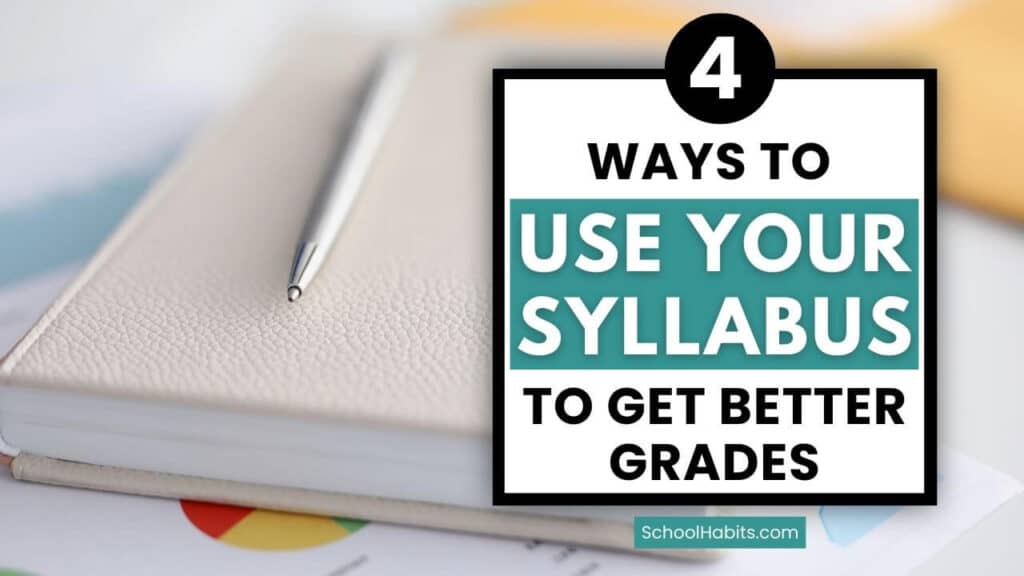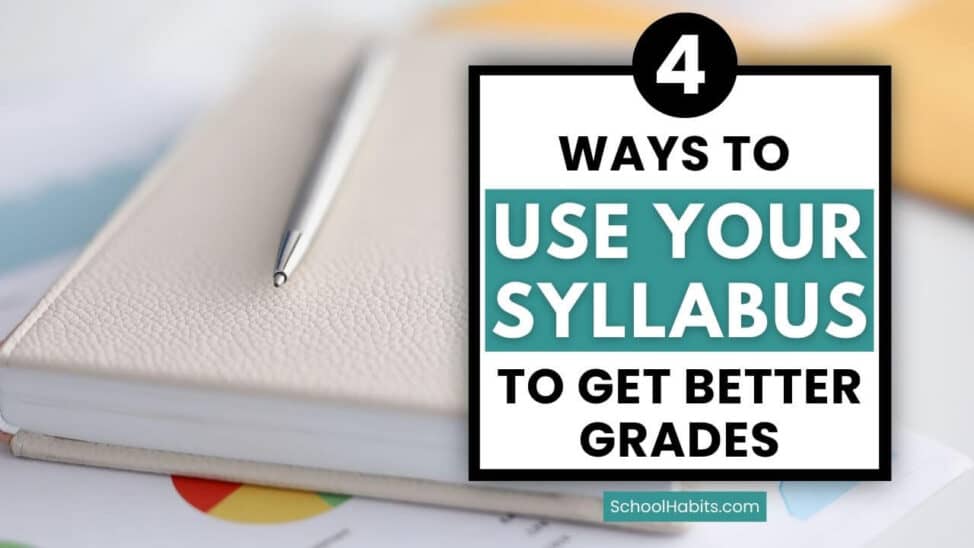
By Katie Azevedo, M.Ed.
So many students receive a course syllabus on the first day of class, review it for a minute, and never look at it again.
Huge mistake! Your syllabus is a source of valuable information that can make your life easier — especially if you’re in college or graduate school. Trust me when I tell you that paying attention to your syllabus can make all the difference.
In this blog post, I teach you four ways to use your syllabus to get better grades. Although the strategies can apply to students in high school, the tips may be most practical to students in college and graduate school.
4 Ways to Use Your Syllabus to Get Better Grades
Your syllabus contains valuable information about assignments, deadlines, due dates, and tests you can expect during the course. This is all information you can use to your advantage to plan out your days and tasks in a way that lowers your stress, and, yes, increases your grades.
1. Use Your Syllabus to Prepare for Class
One way that using your syllabus can help you get better grades is that it allows you to prepare for class.
College and graduate professors very rarely stray from their syllabus, so if the syllabus says you’re going to discuss chapter 3 next week, that is exactly what you will be doing next week.
How is this helpful to you? When you know what you’ll be covering in class, you can do some preparation with the material. This is a strategy called priming. Priming is when you expose yourself to information before learning more deeply about it so that your comprehension is stronger when you cover it in class.
I’ve used this analogy before on my blog, but it’s worth using again: the priming strategy in learning is similar to using a paint primer before you paint a wall so that the paint has something better to stick to.
What does this look like: If you know you’ll be covering chapter 3 in class next week, you could skim chapter 3 ahead of time. You could simply look at the headings and subheadings in your textbook, or… dare I even suggest …you could even read the chapter ahead of time. (Gasp! I know.)
Yes, people do this. It may sound like preparing for class is impossible with your busy schedule, but believe it or not, preparing for class increases what you learn, and therefore decreases your overall study time. Here are my tips 3 tips for preparing for classes.
2. Use your Syllabus to Plan More Effective Study Sessions
Another great use for your syllabus, which can directly increase your grades, is to use it to plan more effective study sessions.
Your syllabus will contain the dates of all your tests and exams. Put these dates on your calendar immediately. But more than that, I want you to start preparing for your tests and exams at least one to two weeks out. You can do this by reverse engineering from the test day, and then planning multiple study sessions every one to two days over those weeks.
This is a strategy called spaced repetition. If you’re not planning study sessions using spaced repetition, start now. With this type of preparation, you don’t need epically long study sessions; you can get away with 20-45 minute sessions if you plan to study on most days leading up to the test.
Preparing for your exams this way is the opposite of what most students do. Most students wait until their teacher announces an exam, and then they wait some more, and then they don’t start studying until one to two days before the test. This “strategy” is quite literally the opposite of what your brain needs to learn new material.
3. Use Your Syllabus to Manage Long-Term Assignments
In addition to giving you test dates, your syllabus also reveals the deadlines for all long-term assignments. Long-term assignments include projects, essays, and essentially any large assignment that’s not due by the next class.
In college and graduate school, professors don’t break down these long-term assignments step-by-step the way high school teachers do. In other words, it’s up to you to keep your eye on the deadline and work towards completing these assignments on time.
When you get your syllabus on the first day of class, in addition to adding in test dates, add in the deadlines of long-term projects. And then, using reverse engineering again, mark a date on your calendar a few weeks out from the deadline. Depending on the size of the project, this could be a month out or a week before. You’ll have to make that decision with the information you have.
PS: If you’re a college student with one or more days with no classes in your weekly schedule, you need to be doing these 5 things on your day no-class days.
Why go through this extra step? Because you should begin working on these long-term projects when you hit that first date in your calendar, the one you marked a few weeks out. Yes, that’s when you should begin these projects, not when your teacher reminds you in class that the deadline is approaching.
Knowing the due dates of long-term projects ahead of time can also help you get through busy periods. For example, if you know you have a busy work schedule next week, and you also have a long-term project due at the end of next week, then your mad awesome syllabus-planning skills will reveal that you need to work on your project THIS week.
If you have multiple projects happening at the same time, use these project management strategies.
4. Use Your Syllabus to Prioritize Your Tasks to Manage Overwhelm
The final way to use your syllabus to get better grades is to use its information about assignment weights to prioritize your time.
As much as you should strive to complete all of your assignments on time, sometimes that can be impossible to do at the college level. In these extenuating cases, it can be helpful to know how each assignment is weighted, so that you can prioritize assignments with greater weights.
In other words, if you have two assignments to complete for tomorrow, and one is worth five points and the other is worth 30, of course it makes sense to work on the one worth 30.
Another way to use assignment weights is to estimate your final grade for the class and adjust your efforts as necessary. If you currently have an 84 in a course, but your goal is a 90, you can use the syllabus to calculate what you need to earn on the remaining tests and assignments to reach your goal. If it’s impossible to reach your goal with the remaining tests/assignments (and their weights), then you know to reach out to your professor to ask about extra credit or alternative means of earning points.
Final Notes About Using Your Syllabus to Get Better Grades
At the college and graduate level, a course syllabus is a valuable tool that you can use to get better grades, organize your time more effectively, and stay balanced throughout a semester. However, the potential value that you can pull from your syllabus is only magic if you do something with it.
Take out your calendar and put those due dates on there. Prepare for classes by reading ahead of time. Beat procrastination by mapping out those long-term projects that you know are coming … because your syllabus says they are. If you’re often overwhelmed by your work and feel like you never have enough time to get it all done, then you need to do something different. That’s the only way you’ll get a different result. Using your syllabus as a (not so) secret weapon just might be the thing you’ve needed all along.

